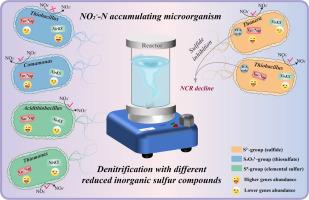当前位置:
X-MOL 学术
›
Water Res.
›
论文详情
Our official English website, www.x-mol.net, welcomes your
feedback! (Note: you will need to create a separate account there.)
Metagenomic insights into nitrite accumulation in sulfur-based denitrification systems utilizing different electron donors: functional microbial communities and metabolic mechanisms
Water Research ( IF 11.4 ) Pub Date : 2024-11-19 , DOI: 10.1016/j.watres.2024.122805 Jiahui Wang, Fangzhai Zhang, Zhaozhi Wang, Haoran Liang, Ziyi Du, Yujing Zhang, Hongying Lu, Yongzhen Peng
Water Research ( IF 11.4 ) Pub Date : 2024-11-19 , DOI: 10.1016/j.watres.2024.122805 Jiahui Wang, Fangzhai Zhang, Zhaozhi Wang, Haoran Liang, Ziyi Du, Yujing Zhang, Hongying Lu, Yongzhen Peng

|
Sulfur-based autotrophic denitrification (SADN) offers new pathway for nitrite supply. However, sequential transformation of nitrogen and sulfur forms, and the functional microorganisms driving nitrite accumulation in SADN with different reduced inorganic sulfur compounds (RISCs), remain unclear. Desirable nitrite accumulation was achieved using elemental sulfur (S0-group), sulfide (S2--group) and thiosulfate (S2O32--group) as electron donors. Under equivalent electron supply conditions, S2O32--group exhibited a superior nitrate conversion rate (NCR) of 0.285 kg N/(m³·d) compared to S2--group (0.103 kg N/(m³·d)). Lower NCR in S2--group was attributed to sulfide strongly inhibiting energy metabolism process of TCA cycle, resulting in reduced reaction rates. Moreover, the NCR of S0-group (0.035 kg N/(m³·d)) was poor due to the chemical inertness of S0. Specific microbial communities were selectively enriched in phylum level, with Proteobacteria increasing to an astonished 96.27-98.49%. Comprehensive analyses of functional genus, genes, and metabolic pathways revealed significant variability in the active functional genus, with even the same genus showed significant metabolic differences in response to different RISCs. In S0-group, Thiomonas (10.0%) and Acidithiobacillus (5.1%) were the primary contributor to nitrite accumulation. Thiobacillus was the most abundant sulfur-oxidizing bacteria in S2--group (43.84%) and S2O32--group (18.92%). In S2--group, it contributed to nitrite accumulation, while in S2O32--group, it acted as a complete denitrifier (NO3--N→N2). Notably, heterotrophic denitrifying bacteria, Comamonas (12.52%), were crucial for nitrite accumulation in S2O32--group, predominating NarG while lacking NirK/S. Overall, this work advances our understanding of SADN systems with different RISCs, offering insights for optimizing nitrogen and sulfur removal.
更新日期:2024-11-19


















































 京公网安备 11010802027423号
京公网安备 11010802027423号